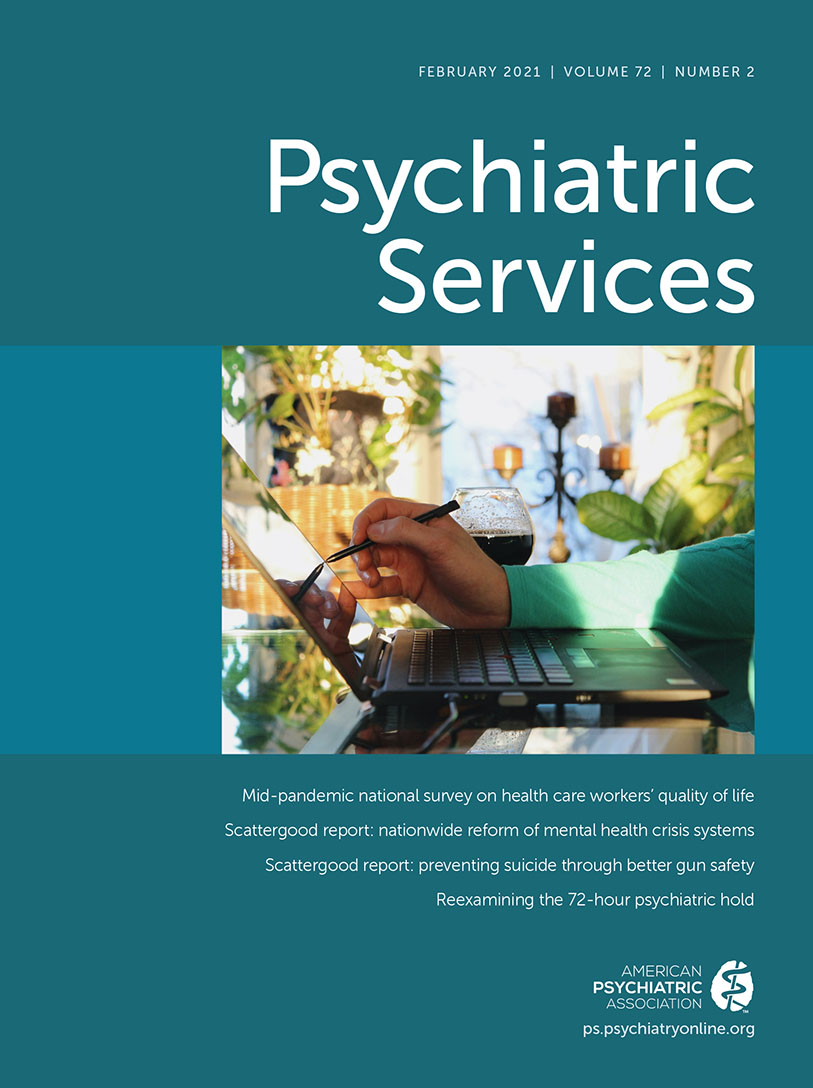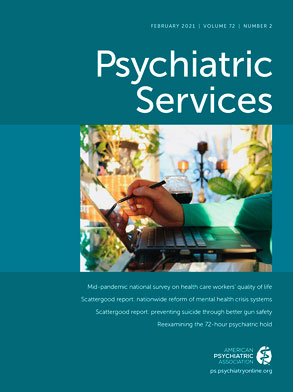In the United States, an estimated 46.6 million adults ages ≥18 years live with some type of mental, behavioral, or emotional disorder (
1). Historically, behavioral health disorders have been undertreated because of barriers related to finances or provider access. Financial barriers are often driven by lack of insurance or by having a health plan that requires high levels of cost-sharing at the point of utilization (e.g., deductibles and coinsurance). Enrollees may also face barriers to high-quality care if the supply of clinical providers in a plan’s network is insufficient for meeting enrollees’ treatment demands.
Federal policies implemented within the past 15 years have sought to improve enrollees’ access to behavioral health care services, including the Mental Health Parity and Addiction Equity Act in 2008 (
2) and the major coverage expansion provisions of the Patient Protection and Affordable Care Act (ACA) in 2014. The ACA enhanced access to behavioral health care services by expanding public and private coverage for Americans with lower incomes through Medicaid eligibility expansion (
3) and the availability of subsidized individual coverage within newly created insurance marketplaces (
4). Additionally, ACA provisions prevent insurers from denying coverage to individuals with preexisting medical conditions and include requirements that insurers cover 10 essential health benefits, including mental health and substance abuse treatment (
5).
Within the ACA, Section 1311 directed the Secretary of Health and Human Services to develop a quality-rating system for health plans offered within the federal and state-based marketplaces. Initiated in 2013, system development took several years, with information on clinical quality and patient experience becoming available to most marketplace enrollees for the first time as they shopped for coverage in the fall of 2019 (
6). The study reported here took advantage of newly released data from the Centers for Medicare and Medicaid Services (CMS) to analyze performance on behavioral health care quality among marketplace plans for 2019 and to determine whether and to what extent performance systematically differed by insurers’ attributes, including plan type, ownership status, Medicaid-managed care status, and Blue Cross–Blue Shield affiliation. Increasing the transparency of health plan quality information may influence enrollee decision making in choosing a plan. Moreover, it may also encourage quality improvement among clinical providers within a given health plan’s network and influence health plans’ contracting decisions with physicians, hospitals, and other care delivery organizations as well as guide the design of new value-based payment models.
Methods
We obtained publicly available data from the 2019 Health Insurance Marketplace Quality Reporting System of the CMS (
7). These data report quality measures based on the Healthcare Effectiveness Data and Information Set measure definitions for 185 of 195 marketplace insurer-product types (e.g., health maintenance organizations [HMOs] and preferred provider organizations [PPOs]) representing 168 marketplace insurers for enrollee populations. We augmented these data with information from a 2016 report of the National Association of Insurance Commissioners and plan participation tracker data from the 2019 Robert Wood Johnson Foundation to classify insurers by whether they were nonprofit insurers, Blue Cross-Blue Shield–affiliated organizations, or Medicaid-managed care insurers, defined as organizations that predominantly served the Medicaid-managed care market segment before 2014 (
8). These insurer attributes were selected on the basis of evidence from the scholarly literature highlighting how insurers’ ownership status, group affiliation, and provider network structures may affect their investments in care quality and treatment outcomes (
9,
10).
Measures of behavioral health care quality often reflect provider and patient actions for a diverse set of clinical populations, diagnoses, and care settings (
11). Four behavioral health care quality measures are reported in the CMS rating system: antidepressant medication management for adults, measured as the average of effective acute and continuation phase treatment rates; follow-up care for children prescribed attention-deficit hyperactivity disorder (ADHD) medication, measured as the average of the initiation and maintenance phase rates; follow-up care within 7 days after hospitalization for mental illness; and adolescents’ and adults’ initiation of and engagement with alcohol and other drug dependence treatment, measured as the average of rates across different treatments and age groups (
12).
We generated descriptive statistics to summarize the rate of performance (mean), variation in performance (SD), and relative variation (coefficient of variation). To examine correlations between behavioral health care measures, we estimated Spearman rank–based correlation coefficients. Finally, we estimated four multivariate linear regression models to investigate the independent association between each insurer-product attribute and each outcome of behavioral health care quality performance. Standard errors were clustered by insurer. Statistical significance was defined as a two-tailed test resulting in p<0.05. This study did not constitute human subjects research and was therefore exempt from institutional review.
Results
Table 1 summarizes quality performance rates on the four behavioral health care measures overall and stratified by insurer attributes. Performance among the 185 insurer-product types was strongest with respect to antidepressant medication management for adults, with a mean performance rate of 62.7%. The next highest performance rate was for follow-up within 7 days after hospitalization for mental illness (43.5%), followed by follow-up care for children prescribed ADHD medication (35.8%). The lowest performance was for initiation and engagement of alcohol and other drug dependence treatment by adolescents and adults, with a mean performance rate of 23.3%. Notably, coefficients of variation indicated that follow-up care for children prescribed ADHD medications and follow-up within 7 days after hospitalization for mental illness exhibited larger relative variation than the other two quality measures.
A related question was whether the quality measures exhibited a high degree of correlation for individual insurers. That is, if an insurer performed relatively better on one quality measure, was it also more likely to perform better on another? To this end, we estimated Spearman correlation coefficients for each bivariate pair of quality measures by using our full sample of 185 insurer-product types (see the online supplement to this article). Although the correlation coefficients were positive for all pairs, only four were statistically significant and were moderate in magnitude (r=0.15–0.33, p<0.05). Specifically, correlation coefficients were largest between follow-up after hospitalization for mental illness and antidepressant medication management (r=0.33) and between follow-up after hospitalization for mental illness and initiation and engagement of alcohol or other drug dependence treatment (r=0.27).
Results from multivariate regression analyses revealed that nonprofit insurers were associated with significantly higher-quality management with antidepressant medication (regression coefficient, 3.13; p<0.05 [
Table 1]), relative to for-profit insurers, after adjusting for other insurer characteristics (group affiliation, product type, and Medicaid-managed care status). We did not observe systematic associations between ownership status and the other three quality outcomes. Medicaid-managed care plans had lower quality on two measures relative to non–Medicaid-managed care plans, including follow-up within 7 days after hospitalization for mental illness (regression coefficient, −13.66; p<0.001) and alcohol and drug dependence treatment (regression coefficient, −3.14; p<0.05). We did not detect any differences by network type (e.g., PPO or not) or Blue Cross–Blue Shield affiliation for the four quality-rating outcomes.
Discussion and Conclusions
Systematic measurement and public reporting of measures of behavioral health care quality can help identify areas of opportunity for improvement among health plans and the providers with whom they contract to better serve their enrollees. Quality information transparency also helps enrollees evaluate their options more comprehensively when selecting their health care plan. This analysis is the first to document current levels of marketplace plan performance with respect to behavioral health care quality. Although overall plan performance for these measures was within the ranges reported for other insurance market segments (e.g., commercial HMO, commercial PPO, Medicaid HMO, and Medicare HMO) in the National Committee for Quality Assurance’s State of Health Care Quality report (
12), wide variation existed across the measures, with performance being highest for antidepressant medication management at 62.7% and lowest for initiation and engagement of alcohol and other drug dependence treatment at 23.3%. Variation also existed across insurer-product attributes. Importantly, Medicaid-managed care plans performed significantly lower on two of the four measures: follow-up after hospitalization for mental illness and initiation and engagement of alcohol and other drug dependence treatment.
As with many health care outcomes, the measures analyzed here may have been influenced by enrollee-driven, provider-driven, and plan-driven factors (
13). For example, enrollee preferences may have affected both adherence to antidepressant medications as well as willingness to seek follow-up care from a provider. For some enrollees, decisions to take these medications or make follow-up appointments may have been related to additional financial costs arising from deductibles or coinsurance.
Provider- and plan-driven efforts also have the potential to influence behavioral health care quality performance. Provider-driven tactics may include the use of e-mail or text messaging to remind patients to seek follow-up treatment, use of care coordinators to help patients navigate the system, or adoption of new care delivery options (e.g., walk-in clinics). Health plan administrators can also influence quality. Plan administrators may collaborate with providers to support quality improvement initiatives by providing data feeds or other technical assistance. Plan administrators may also encourage performance improvement by creating explicit incentives through value-based payment arrangements. Importantly, the extent to which insurers are willing to invest in clinical quality improvement depends heavily on return on investment. In the individual market, this metric is likely to be more challenging, given the perceived higher rates of churn within this insurance market segment relative to others (e.g., employer group or Medicare Advantage).
Strategic decision making by health plan administrators around network design may also influence enrollees’ access to behavioral and other types of health care services. Notably, in the individual market, insurers have sought to lower premiums by utilizing narrower provider networks for marketplace plans (
14). Although this approach may enable plans to compete more effectively for enrollees on the basis of price, the narrower networks may have provider numbers, compositions, or geographic distributions that are inadequate for meeting enrollees’ care demands. For example, a recent report by the U.S. Department of Health and Human Services noted that provider network size and composition have been important factors affecting enrollees’ ability to seek substance use treatment (
15).
Given the novelty of quality information transparency in the individual market, additional research is needed to better understand how key stakeholders use the plan quality information. For example, future studies could investigate how insurers invest in quality improvement activities and how enrollees use this information to choose their health plans.

